1996 CHEVROLET CORVETTE inflation pressure
[x] Cancel search: inflation pressurePage 189 of 386

Downloaded from www.Manualslib.com manuals search engine Loading Your Vehicle
Tm OCCUPANTS VEHICLE CAP. WT.
TIRE-LOADING
INFORMATION
FRT. CTR. RR. TOTAL LBS. KG
MAX. LOADING & GVWR SAME AS VEHICLE
CAPACITY WEIGHT XXX COLD TIRE
TIRE
SIZE SPEED PRESSURE
RTG PSI/KPa
FRT.
RR.
SPA. IF TIRES ARE HOT, ADD 4PS1/28KPa
SEE OWNER‘S MANUAL FOR ADDITIONAL
INFORMATION
Two labels on your vehicle show how much weight it
may properly carry. The Tire-Loading Information label
found on the rear edge of the driver’s door tells you the
proper size, speed rating and recommended inflation.
It
also gives you important information about the number
of people that can be in your vehicle and the total weight
that you can carry. This weight is called Vehicle
Capacity Weight and includes the weight of all
occupants, cargo, and all nonfactory-installed options.
f I
MFD BY GENERAL MOTORS CORP
DATE GVWR GAWR FRT GAWR RR
THIS VEHICLE CONFORMS TO ALL APPLI-
CABLE
U.S. FEDERAL MOTOR VEHICLE
SAFETY, BUMPER, AND THEFT PREVENTION
STANDARDS
IN EFFECT ON THE DATE OF
MANUFACTURE SHOWN ABOVE.
The other label is the Certification label, found on the rear
edge of the driver’s door. It tells you the
gross weight
capacity of your vehicle, called the GVWR (Gross Vehicle
Weight Rating). The
GVWR includes the weight of the
vehicle, all occupants, fuel and cargo. Never exceed
the
GVWR for your vehicle, or the GAWR (Gross Axle
Weight Rating) for either the front or rear axle.
And, if you do have a heavy load, you should spread it
out. Don’t carry more than
100 pounds (45 kg) in your
rear area.
Page 229 of 386

Downloaded from www.Manualslib.com manuals search engine Put the jack, wheel nut socket and wheel lock key in the
rear storage compartment behind the passenger’s seat.
Make sure the parts are stored properly in the foam
container. Position the jack in the container
so that you
can read the yellow CAUTION label fromthe driver’s
seat. Replace the plastic tray and close the storage
compartment.
NOTICE:
Your Corvette’s radio receiver box is in the rear
storage compartment.
To help avoid damage,
carefully place the jack, socket and wheel lock
key into the foam container in the compartment.
Do not toss or place the items against the radio
receiver box or any wiring.
Compact Spare Tire (If So Equipped)
Although the compact spare tire was fully inflated when
your vehicle was new, it can lose air after a time. Check
the’inflation pressure regularly. It should be
60 psi
(420 Wa).
After installing the compact spare on your vehicle, you should stop as soon as possible and make sure your spare
tire is correctly inflated. The compact spare is made to
perform well at posted speed limits for distances up to
3,000 miles (5 OOO km), so you can finish your trip and
have your full-size tire repaired or replaced where you
want.
Of course, it’s best to replace your spare with a
full-size tire as soon
as you can. Your spare will last
longer and
be in good shape in case you need it again.
When the compact spare is installed, your
vehicle’s handling capabilities will be reduced
during severe maneuvers.
If you drive too fast,
you could lose control
of your vehicle. You or
others could be injured. Don’t drive over
55 mph
(90 km/h) when the compact spare is installed.
5-38
Page 277 of 386
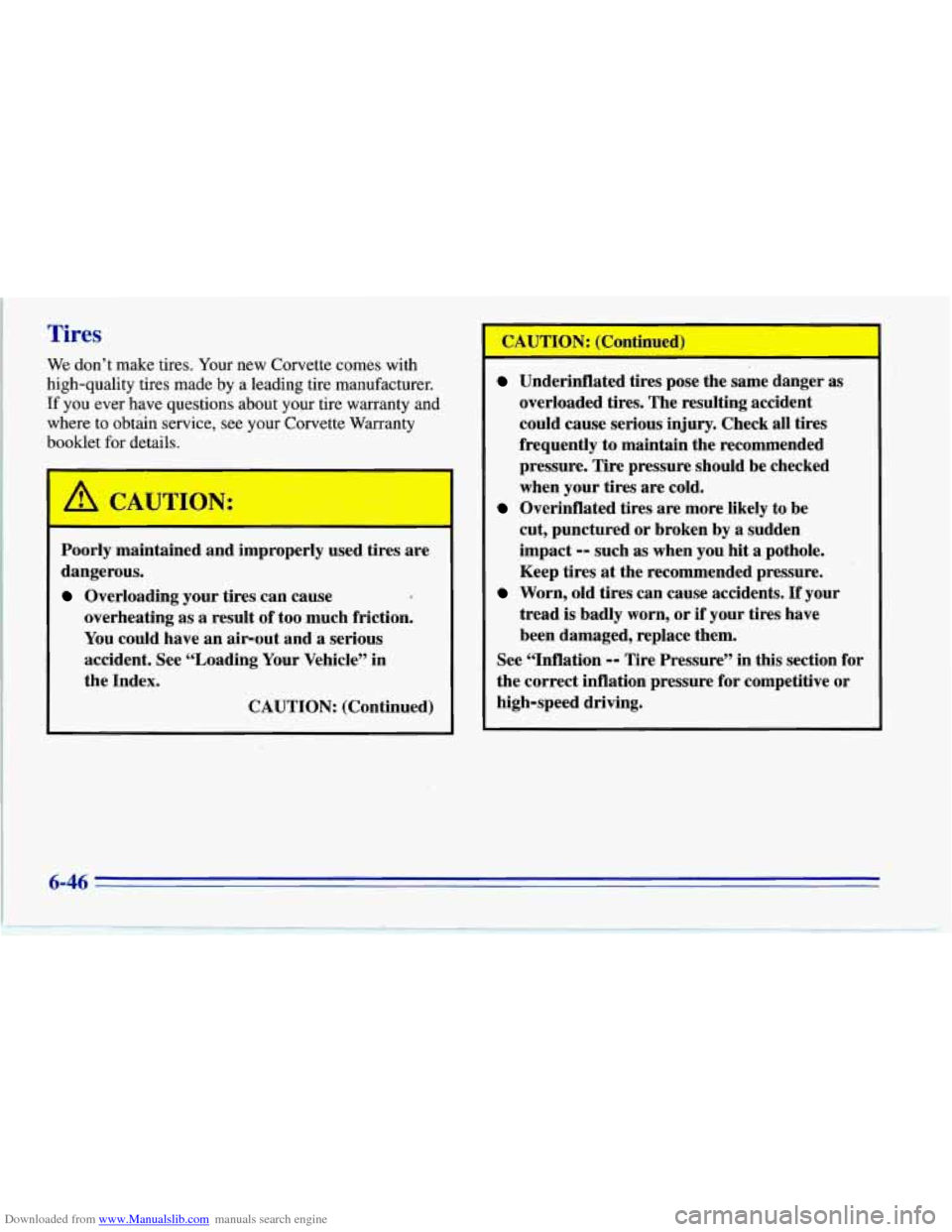
Downloaded from www.Manualslib.com manuals search engine Tires
We don’t make tires. Your new Corvette comes with
high-quality tires made by a leading tire manufacturer.
If you ever have questions about your tire warranty and
where to obtain service, see your Corvette Warranty
booklet for details.
Poorly maintained and improperly used tires are
dangerous.
Overloading your tires can cause
overheating as
a result of too much friction.
You could have an air-out and a serious
accident. See “Loading Your Vehicle” in
the Index.
CAUTION: (Continued) CAUTION: (Co
Underinflated tires
pose the same danger as
overloaded tires. The resulting accident
could cause serious injury. Check all tires
frequently to maintain the recommended
pressure. Tire pressure should be checked
when your tires are cold.
cut, punctured or broken by a sudden
impact
-- such as when you hit a pothole.
Keep tires
at the recommended pressure.
Worn, old tires can cause accidents. If your
tread
is badly worn, or if your tires have
been damaged, replace them.
Overinflated tires are more likely to be
See “1nfla.tion
-- Tire Pressure” in this section for
the correct inflation pressure for competitive or
high-speed driving.
Page 278 of 386
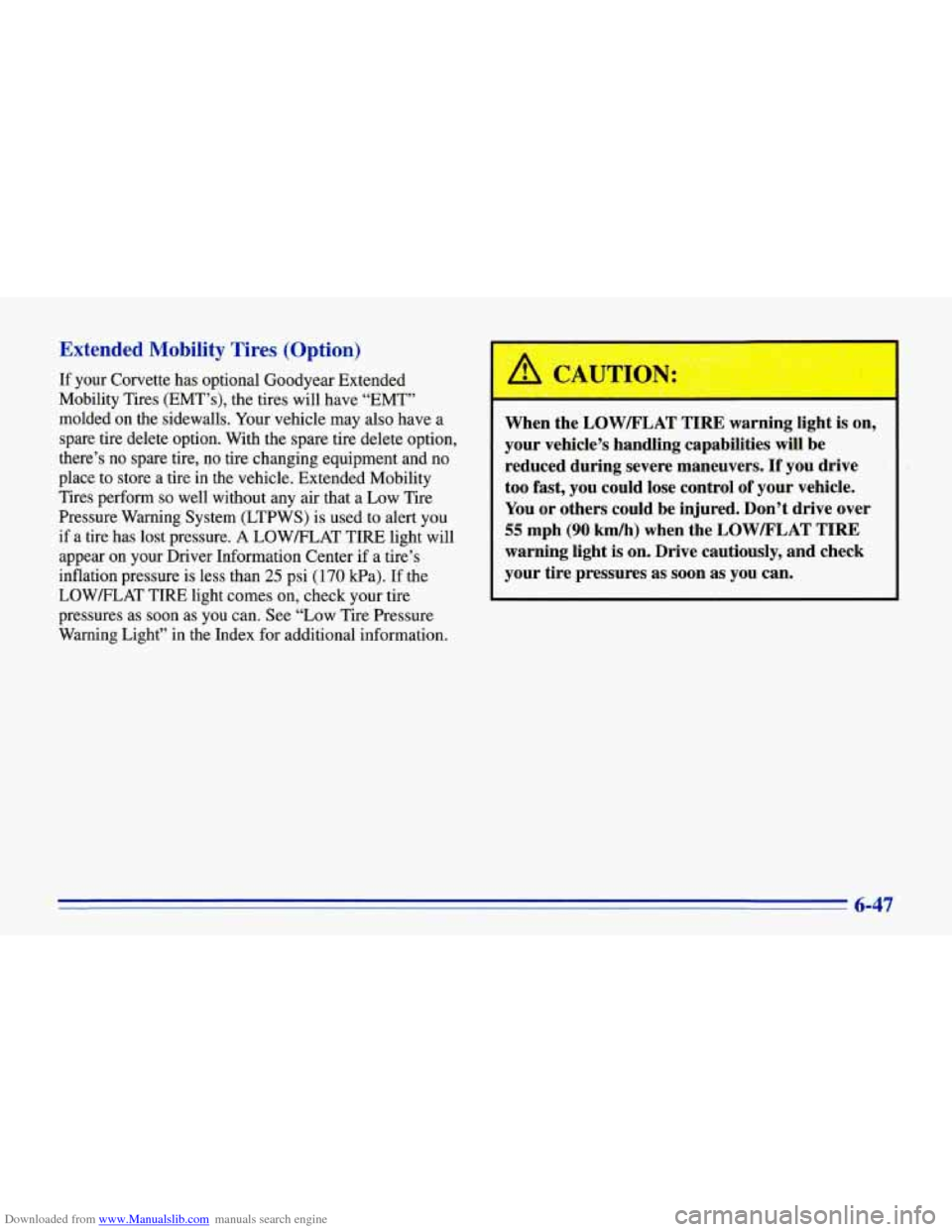
Downloaded from www.Manualslib.com manuals search engine Extended Mobility Tires (Option)
If your Corvette has optional Goodyear Extended
Mobility Tires
(EMT’s), the tires will have “EMT”
molded on the sidewalls. Your vehicle may also have a
spare tire delete option. With the spare tire delete option,
there’s no spare tire,
no tire changing equipment and no
place to store
a tire in the vehicle. Extended Mobility
Tires perform
so well without any air that a Low Tire
Pressure Warning System (LTPWS) is used to alert you
if a tire has lost pressure. A LOWFLAT TIRE light will
appear on your Driver Information Center if a tire’s
inflation pressure is less than
25 psi (170 kPa). If the
LOWFLAT TIRE light comes
on, check your tire
pressures as soon as you can. See
“Low Tire Pressure
Warning Light” in the Index for additional information.
When the LOWELAT TIRE warning light is on,
your vehicle’s handling capabilities will be
reduced during severe maneuvers.
If you drive
too fast, you could lose control of your vehicle.
You or others could be injured. Don’t drive over 1 ,
55 mph (90 kmh) when the LOWLFLAT TIRE
warning light
is on. Drive cautiously, and check
your tire pressures as soon as you can.
I
6-47
Page 279 of 386
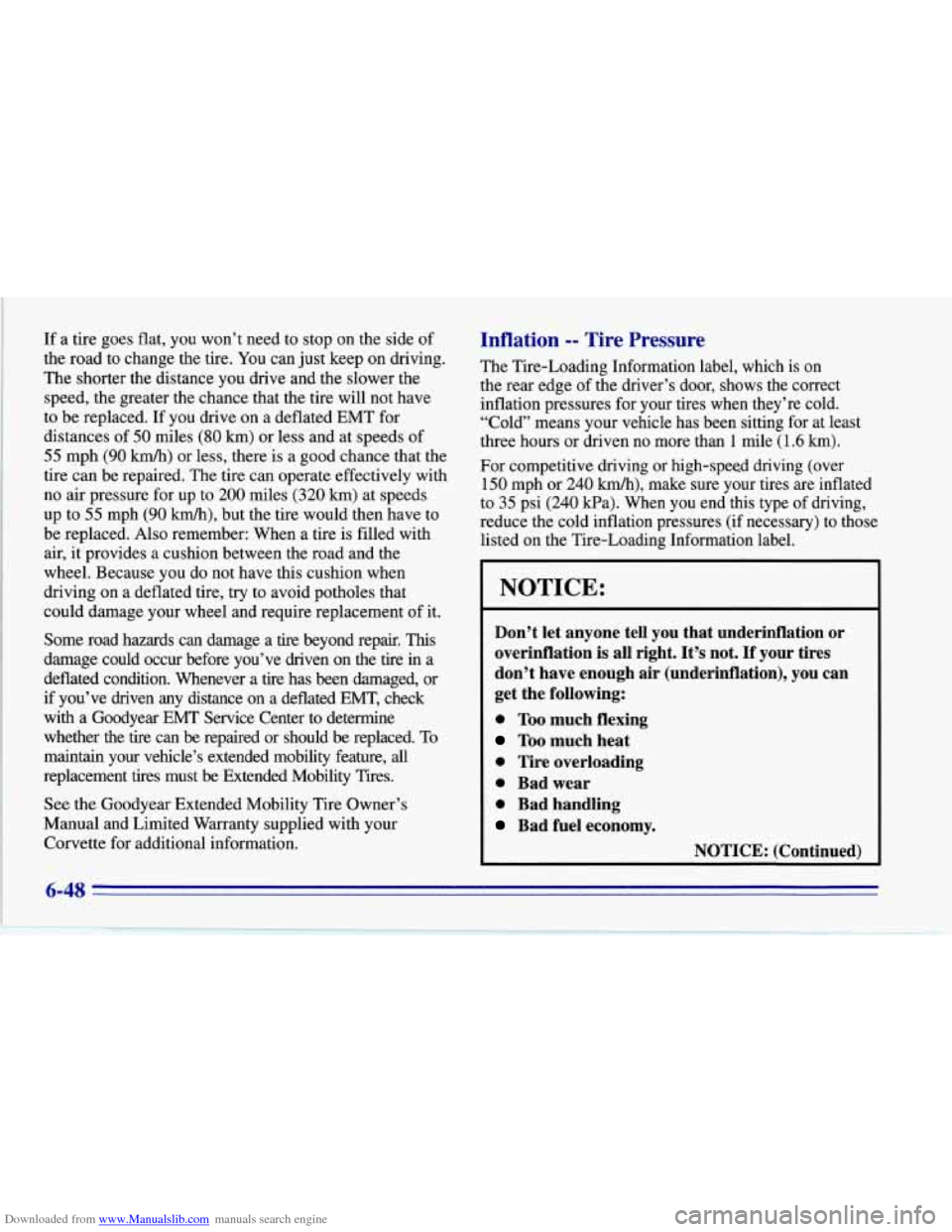
Downloaded from www.Manualslib.com manuals search engine If a tire goes flat, you won’t need to stop on the side of
the road to change the tire.
You can just keep on driving.
The shorter the distance you drive and the slower the
speed, the greater the chance that the tire will not have
to be replaced. If you drive on a deflated EMT for
distances of
50 miles (80 km) or less and at speeds of
55 mph (90 km/h) or less, there is a good chance that the
tire can be repaired. The tire can operate effectively with
no air pressure for up to 200 miles (320 km) at speeds
up to
55 mph (90 km/h), but the tire would then have to
be replaced. Also remember: When a tire is filled with
air, it provides a cushion between the road and the
wheel. Because you do not have this cushion when
driving on a deflated tire, try to avoid potholes that
could damage your wheel and require replacement of it.
Some road hazards can damage a
tire beyond repair. This
damage could occur before you’ve driven on the tire in a
deflated condition. Whenever a tire has been damaged, or
if you’ve driven any distance on a deflated
EMT, check
with a Goodyear EMT Service Center to determine
whether the tire can be repaired or should be replaced. To
maintain your vehicle’s extended mobility feature,
all
replacement tires must be Extended Mobility Tires.
See the Goodyear Extended Mobility Tire Owner’s
Manual and Limited Warranty supplied with your
Corvette for additional information.
Inflation -- Tire Pressure
The Tire-Loading Information label, which is on
the rear edge of the driver’s door, shows the correct
inflation pressures for your tires when they’re cold.
“Cold” means your vehicle has been sitting for at least
three hours or driven no more than
1 mile (1.6 km).
For competitive driving or high-speed driving (over
150 mph or 240 km/h), make sure your tires are inflated
to 35 psi
(240 kPa). When you end this type of driving,
reduce the cold inflation pressures (if necessary) to those
listed on the Tire-Loading Information label.
I NOTICE:
Don’t let anyone tell you that underinflation or
overinflation is all right. It’s not. If your tires
don’t have enough air (underinflation), you can get the following:
0 Too much flexing
Too much heat
0 Tire overloading
0 Bad wear
0 Bad handling
Bad fuel economy.
NOTICE: (Continued)
Page 280 of 386

Downloaded from www.Manualslib.com manuals search engine I NOTICE: (Continued) I
If your tires have too much air (overinflation),
you can get the following:
Unusual wear
Bad handling
Rough ride
Needless damage from road hazards.
When to Check
Check your tires once a month or more.
If you have a compact spare tire, it should be at
60 psi (420 Wa).
How to Check
Use a good quality pocket-type gage to check tire
pressure. You can’t tell if your tires are properly inflated
simply by looking at them. Radial tires may look
properly inflated even when they’re underinflated.
Be sure to put the valve caps back on the valve
stems. They help prevent leaks by keeping out dirt
and moisture.
Tire Rotation
The tires on your Corvette are directional, asymmetrical
and are different sizes front to rear. Due to this, your
tires should not be rotated. Each tire and wheel should
be used only in the position it is in.
When It’s Time for New Tires
One way to tell when it’s time for new tires is to check the
treadwear indicators, which will appear when your tires
have
only 1/16 inch (1.6 mm) or less of tread remaining.
6-49
Page 351 of 386
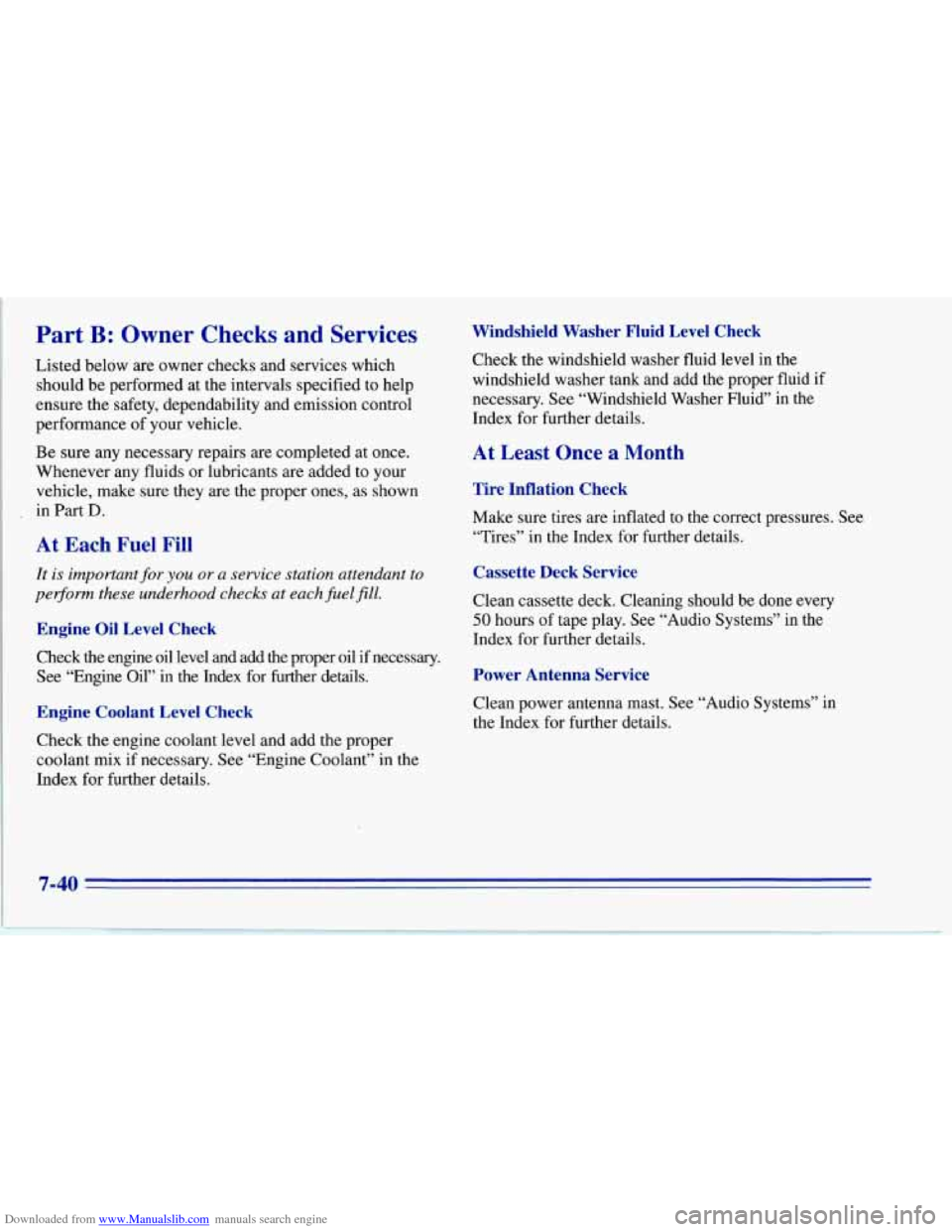
Downloaded from www.Manualslib.com manuals search engine Part B: Owner Checks and Services
Listed below are owner checks and services which
should be performed at the intervals specified to help
ensure the safety, dependability and emission control
performance of your vehicle.
Be sure any necessary repairs are completed at once.
Whenever any fluids
or lubricants are added to your
vehicle, make sure they are the proper ones, as shown
in Part
D.
At Each Fuel Fill
It is important for you or a service station attendant to
pegorm these underhood checks at each fuel
fill.
Engine Oil Level Check
Check the engine oil level and add the proper oil if necessary.
See “Engine Oil” in the Index for further details.
Engine Coolant Level Check
Check the engine coolant level and add the proper
coolant mix if necessary. See “Engine Coolant” in the
Index for further details.
Windshield Washer Fluid Level Check
Check the windshield washer fluid level in the
windshield washer tank and add the proper fluid if
necessary. See “Windshield Washer Fluid” in the
Index for further details.
At Least Once a Month
Tire Inflation Check
Make sure tires are inflated to the correct pressures. See
“Tires” in the Index for further details.
Cassette Deck Service
Clean cassette deck. Cleaning should be done every
50 hours of tape play. See “Audio Systems” in the
Index for further details.
Power Antenna Service
Clean power antenna mast. See “Audio Systems” in
the Index for further details.
7-40
Page 384 of 386
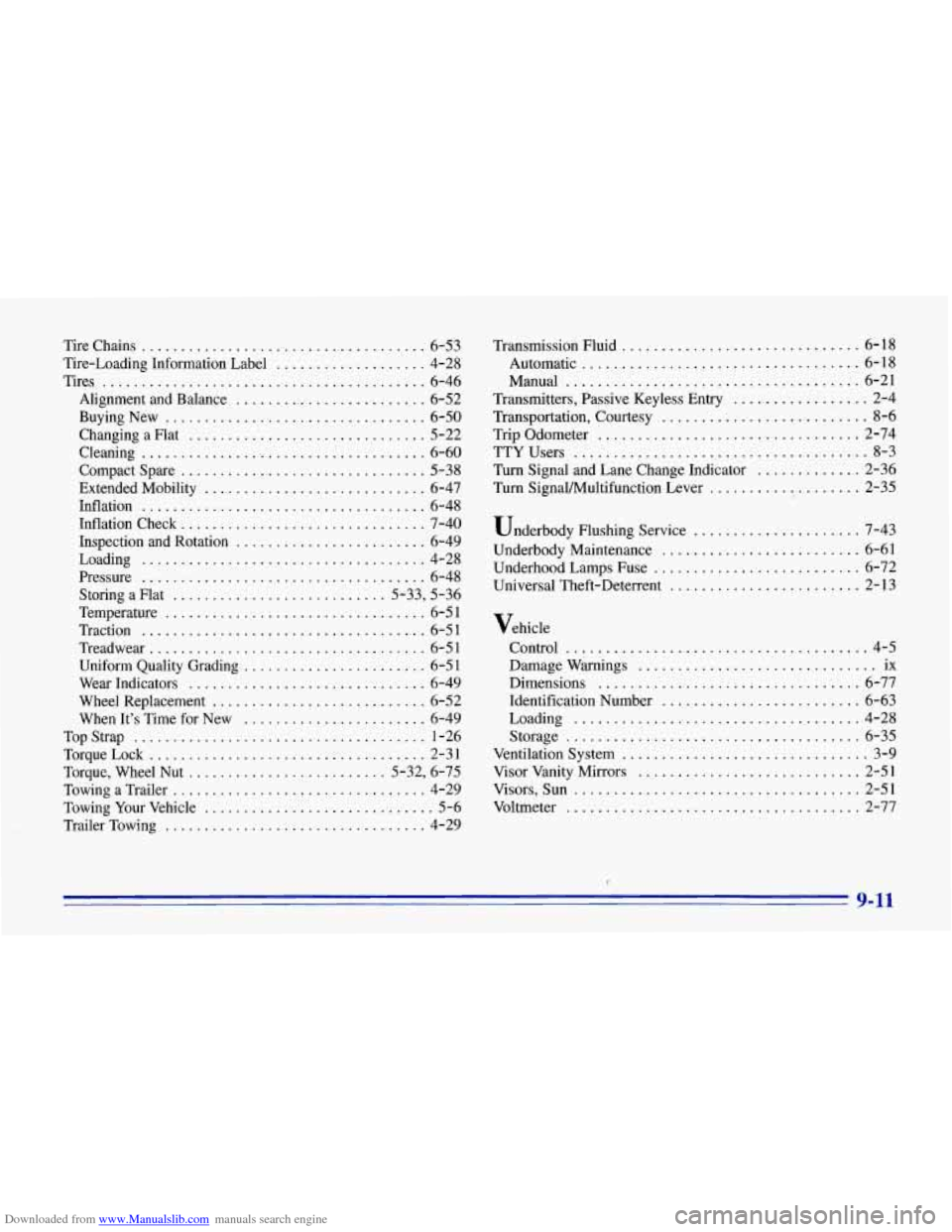
Downloaded from www.Manualslib.com manuals search engine Tire Chains .................................. 6-53
Tire-Loading Information Label
................... 4-28
Tires
......................................... 6-46
Alignment and Balance
........................ 6-52
BuyingNew
................................. 6-50
Changing a Flat
.............................. 5-22
Cleaning
.................................... 6-60
Compact Spare
............................... 5-38
Extended Mobility
............................ 6-47
Inflation
.................................... 6-48
Inflation Check
............................... 7-40
Inspection and Rotation
........................ 6-49
Loading
.................................... 4-28
Pressure
.................................... 6-48
Storing a Flat
........................... 5-33, 5-36
Temperature
................................. 6-5 1
Traction .................................... 6-51
Treadwe
ar ................................... 6-51
Uniform Quality Grading
....................... 6-51
Wear Indicators
.............................. 6-49
Wheel Replacement
........................... 6-52
When It’s Time for New
....................... 6-49
TorqueLock
................................... 2-31
Torque, Wheel Nut
......................... 5-32, 6-75
Towing a Trailer
................................ 4-29
Towing Your Vehicle
............................. 5-6
Trailer Towing
............................... 4-29
TopStrap
..................................... 1-26 Transmission Fluid
.............................. 6-18
Automatic
................................... 6-18
Manual
..................................... 6-21
Transmitters. Passive Keyless Entry
................. 2-4
Transportation. Courtesy
.......................... 8-6
Trip Odometer
................................. 2-74
TTYUsers
..................................... 8-3
Turn Signal and Lane Change Indicator
............. 2-36
Turn Signalklultifunction Lever
................... 2-35
Underbody Flushing Service
..................... 7-43
Underbody Maintenance
......................... 6-61
Universal Theft-Deterrent
........................ 2-13
UnderhoodLampsFuse
.......................... 6-72
Vehicle Control
...................................... 4-5
Damage Warnings
.............................. ix
Dimensions
................................. 6-77
Identification Number
......................... 6-63
Loading
.................................... 4-28
Ventilation System
............................... 3-9
Visor Vanity
Mirrors ............................ 2-51
Visors, Sun
.................................... 2-51
Voltmeter
..................................... 2-77
Storage
..................................... 6-35
I
9-11